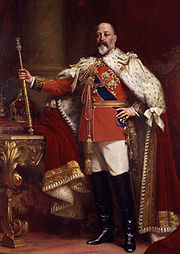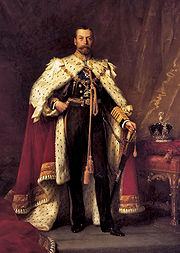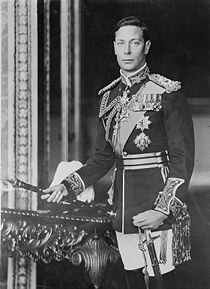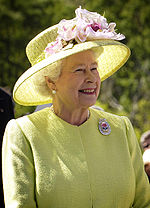
List of Niuean monarchs
Encyclopedia
This is a list of monarchs
who have reigned over the Pacific island of Niue
. The island today is a self-governing territory in free association
with New Zealand
, and recognises the Queen of New Zealand as monarch. Before this, however, the island previously had an indigenous monarchy, established around the beginning of the 18th century.
Before that time, there appears to have been no national government or national leader in Niue. Chiefs and heads of family exercised authority over segments of the population. Around 1700, the concept and practice of kingship appears to have been introduced through contact with Samoa or Tonga. From then on, a succession of patu-iki
(kings) ruled the island, the first of whom was Puni-mata. The function of monarch was non-hereditary; patu-iki were reportedly elected by the Niuean population, with the candidates being issued from influential families. As described by Stephenson Percy Smith
in 1903, Niue appears therefore to have been a democratic
elective monarchy
.
, which administered it in the name of the British Empire. On 26 September 1907, New Zealand attained the status of dominion, becoming the Dominion of New Zealand
, and the British monarch from then on reigned over Niue in his or her capacity as monarch of New Zealand. Elizabeth II
was the first monarch to be explicitly titled Queen of New Zealand, however, in 1952. Today, Niue is part of the Realm of New Zealand
, the successor political entity to the dominion.
Monarchy
A monarchy is a form of government in which the office of head of state is usually held until death or abdication and is often hereditary and includes a royal house. In some cases, the monarch is elected...
who have reigned over the Pacific island of Niue
Niue
Niue , is an island country in the South Pacific Ocean. It is commonly known as the "Rock of Polynesia", and inhabitants of the island call it "the Rock" for short. Niue is northeast of New Zealand in a triangle between Tonga to the southwest, the Samoas to the northwest, and the Cook Islands to...
. The island today is a self-governing territory in free association
Associated state
An associated state is the minor partner in a formal, free relationship between a political territory with a degree of statehood and a nation, for which no other specific term, such as protectorate, is adopted...
with New Zealand
New Zealand
New Zealand is an island country in the south-western Pacific Ocean comprising two main landmasses and numerous smaller islands. The country is situated some east of Australia across the Tasman Sea, and roughly south of the Pacific island nations of New Caledonia, Fiji, and Tonga...
, and recognises the Queen of New Zealand as monarch. Before this, however, the island previously had an indigenous monarchy, established around the beginning of the 18th century.
Before that time, there appears to have been no national government or national leader in Niue. Chiefs and heads of family exercised authority over segments of the population. Around 1700, the concept and practice of kingship appears to have been introduced through contact with Samoa or Tonga. From then on, a succession of patu-iki
Patu-iki
Patu-iki is the title that was given to the kings of the Pacific Ocean island of Niue. This indigenous monarchy ruled the island from the early eighteenth century, prior to which there had been no nationally organised government of the island, which was instead run by local chieftains...
(kings) ruled the island, the first of whom was Puni-mata. The function of monarch was non-hereditary; patu-iki were reportedly elected by the Niuean population, with the candidates being issued from influential families. As described by Stephenson Percy Smith
Stephenson Percy Smith
Stephenson Percy Smith was a New Zealand ethnologist and surveyor. He founded The Polynesian Society.-Early life and career as a surveyor :...
in 1903, Niue appears therefore to have been a democratic
Democracy
Democracy is generally defined as a form of government in which all adult citizens have an equal say in the decisions that affect their lives. Ideally, this includes equal participation in the proposal, development and passage of legislation into law...
elective monarchy
Elective monarchy
An elective monarchy is a monarchy ruled by an elected rather than hereditary monarch. The manner of election, the nature of the candidacy and the electors vary from case to case...
.
List of patu-iki
| Name | Portrait | Birth | Death | Start | End | Notes |
|---|---|---|---|---|---|---|
| Puni-mata | ? | ? | c. 1700 | ? | He was the first patu-iki. His death, of old age, was followed by an interregnum Interregnum An interregnum is a period of discontinuity or "gap" in a government, organization, or social order... of significant but indeterminate length. |
|
| Patua-valu | ? | ? | ? | ? | He was nominated for kingship by the population's elected choice, Tage-lagi, who declined the position and opted instead to be Patua-valu's lifelong bodyguard. Patua-valu died of old age. | |
| Galiga, also known as Galiaga-a-Iki and Galiaga of Palūki | ? | ? | ? | ? | This patu-iki was murdered by a person called Tikomata. Following his death, Fakana-iki and Hetalaga vied to replace him, but failed to secure the approval of the population. Foki-mata eventually became the fourth patu-iki instead. He was the last king elected in times of peace. | |
| Foki-mata | ? | 1874? | ? | 1874? | ||
| Pakieto | ? | 1875? | 1874? | 1875? | He was patu-iki for only a year. Following his death, a war of succession occurred. He was one of the Tama-lagau people. | |
| Tui-toga, also known as Ta-tagata | ? | June 13, 1887 | March 2, 1885 | June 13, 1887 | The first Christian King of Niue. | |
| Fata-a-iki Fata-a-iki Fata-a-iki was a patu-iki of the Pacific Ocean island of Niue.-Reign:Fata-a-iki ruled from 1887 to 1896. He was the seventh king of the island, and the second to be of the Christian faith, he was anointed on November 21, 1888, although he began ruling the island the previous year, following the... |
? | 1896 | 1887 (de facto) November 21, 1888 (de jure) |
1896 | The second Christian Niuean monarch. One of his first acts as patu-iki in 1877 was to send a letter to the British monarch Monarchy of the United Kingdom The monarchy of the United Kingdom is the constitutional monarchy of the United Kingdom and its overseas territories. The present monarch, Queen Elizabeth II, has reigned since 6 February 1952. She and her immediate family undertake various official, ceremonial and representational duties... Queen Victoria Victoria of the United Kingdom Victoria was the monarch of the United Kingdom of Great Britain and Ireland from 20 June 1837 until her death. From 1 May 1876, she used the additional title of Empress of India.... , requesting that Niue be made a protectorate of the British Empire British Empire The British Empire comprised the dominions, colonies, protectorates, mandates and other territories ruled or administered by the United Kingdom. It originated with the overseas colonies and trading posts established by England in the late 16th and early 17th centuries. At its height, it was the... , to protect the island from other imperial powers, although his letter (and another sent in 1895) received no replies. |
|
| Togia-Pulu-toaki Togia-Pulu-toaki Togia-Pulu-toaki was the eighth and possibly final patu-iki of the Pacific Ocean island of Niue, taking power in 1896 following the death of the previous incumbent, Fata-a-iki, and formally ordained on June 30, 1898.... |
? | ? | 1896 (de facto) June 30, 1898 (de jure) |
? | He was the king who finally ceded Niue to the British Empire on April 21, 1900, and who welcomed a Resident representative of the imperial government on Niue on September 11, 1901. Togia-Pulu-toaki remained patu-iki in 1903, when Niuē-fekai (or Savage) Island and its People was published and the date of his death, and whether or not he was succeeded, remains unclear. |
Imperial rule and free association
From 1900 to 1901, Niue was ruled by the United Kingdom. In 1901, the island was annexed by New ZealandNew Zealand
New Zealand is an island country in the south-western Pacific Ocean comprising two main landmasses and numerous smaller islands. The country is situated some east of Australia across the Tasman Sea, and roughly south of the Pacific island nations of New Caledonia, Fiji, and Tonga...
, which administered it in the name of the British Empire. On 26 September 1907, New Zealand attained the status of dominion, becoming the Dominion of New Zealand
Dominion of New Zealand
The Dominion of New Zealand is the former name of the Realm of New Zealand.Originally administered from New South Wales, New Zealand became a direct British colony in 1841 and received a large measure of self-government following the New Zealand Constitution Act 1852...
, and the British monarch from then on reigned over Niue in his or her capacity as monarch of New Zealand. Elizabeth II
Elizabeth II of the United Kingdom
Elizabeth II is the constitutional monarch of 16 sovereign states known as the Commonwealth realms: the United Kingdom, Canada, Australia, New Zealand, Jamaica, Barbados, the Bahamas, Grenada, Papua New Guinea, the Solomon Islands, Tuvalu, Saint Lucia, Saint Vincent and the Grenadines, Belize,...
was the first monarch to be explicitly titled Queen of New Zealand, however, in 1952. Today, Niue is part of the Realm of New Zealand
Realm of New Zealand
The Realm of New Zealand is the entire area in which the Queen in right of New Zealand is head of state. The Realm comprises New Zealand, the Cook Islands, Niue, Tokelau and the Ross Dependency in Antarctica, and is defined by a 1983 Letters Patent constituting the office of Governor-General of New...
, the successor political entity to the dominion.
List of British monarchs ruling over Niue
| Name | Portrait | Birth | Death | Start | End |
|---|---|---|---|---|---|
| Victoria Victoria of the United Kingdom Victoria was the monarch of the United Kingdom of Great Britain and Ireland from 20 June 1837 until her death. From 1 May 1876, she used the additional title of Empress of India.... |
 |
24 May 1819 | 22 January 1901 | April 21, 1900 (de facto) | 22 January 1901 |
| Edward VII Edward VII of the United Kingdom Edward VII was King of the United Kingdom and the British Dominions and Emperor of India from 22 January 1901 until his death in 1910... |
 |
9 November 1841 | 6 May 1910 | 22 January 1901 | 26 September 1907 |
List of New Zealand monarchs ruling over Niue
| Name | Portrait | Birth | Death | Start | End |
|---|---|---|---|---|---|
| Edward VII Edward VII of the United Kingdom Edward VII was King of the United Kingdom and the British Dominions and Emperor of India from 22 January 1901 until his death in 1910... |
 |
9 November 1841 | 6 May 1910 | 26 September 1907 | 6 May 1910 |
| George V George V of the United Kingdom George V was King of the United Kingdom and the British Dominions, and Emperor of India, from 6 May 1910 through the First World War until his death in 1936.... |
 |
3 June 1865 | 20 January 1936 | 6 May 1910 | 20 January 1936 |
| Edward VIII Edward VIII of the United Kingdom Edward VIII was King of the United Kingdom and the Dominions of the British Commonwealth, and Emperor of India, from 20 January to 11 December 1936.Before his accession to the throne, Edward was Prince of Wales and Duke of Cornwall and Rothesay... |
 |
23 June 1894 | 28 May 1972 | 20 January 1936 | 11 December 1936 |
| George VI George VI of the United Kingdom George VI was King of the United Kingdom and the Dominions of the British Commonwealth from 11 December 1936 until his death... |
 |
14 December 1895 | 6 February 1952 | 11 December 1936 | 6 February 1952 |
| Elizabeth II Elizabeth II of the United Kingdom Elizabeth II is the constitutional monarch of 16 sovereign states known as the Commonwealth realms: the United Kingdom, Canada, Australia, New Zealand, Jamaica, Barbados, the Bahamas, Grenada, Papua New Guinea, the Solomon Islands, Tuvalu, Saint Lucia, Saint Vincent and the Grenadines, Belize,... |
 |
21 April 1926 | Living | 6 February 1952 | Incumbent |
Source
- S. Percy Smith, Niuē-fekai (or Savage) Island and its People, 1903, pp. 36–44

